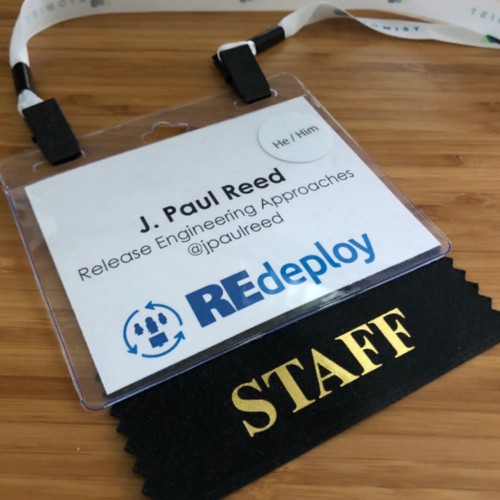I Ran This Whole Conference and I Didn't Even Get a T-shirt
April 11, 2019

As many of you know, Mary Thengvall and I produced and co-chaired REdeploy last year, a conference on the intersection of resilient technology, organizations, and people. Mary recently posted a three-part retrospective series on the conference.
Despite ignoring my own advice about running retrospectives within 72 hours after incidents, here are some of my musings about the 2018 event (based largely on notes I, at least, did take in the days after):
On “Making the Sausage” — First and foremost, I think producing a conference was particularly eye-opening: both Mary and I do quite a bit of public speaking internationally (and Mary has plenty of experience wrangling conference logistics), so we both thought we had a pretty good idea of what “making the sausage” of a conference would look like.
Boy were we wrong. Instead of seasoning some pork and putting it into a nice casing, a more apt analogy for the level of involvement we found ourselves facing was someone handing us a bolt gun and a meat cleaver, and pointing us to a room with a squealing pig. We would learn this lesson a few times throughout the experience. It was a valuable one, but… it was certainly unexpected.
How Many Zeroes?! — Relatedly, Mary and I produced this conference ourselves. It’s a fact that, honestly, I am pretty proud of. That said, it required writing a lot of checks, with a lot of zeros on them, and that level of commitment was pretty scary. That doesn’t mean to imply that we went it alone: we had a group of amazing sponsors for this inaugural event and a great set of friends who helped us connect with a community that’s very interested in Resilience Engineering and what RE means for the future of software development and operations … but it took a lot of effort (and, some may say, courage) up front and that shouldn’t be underestimated. (I’d like to thank my Mary again for that.)
-
Infrastructure Matters — Getting things like the conference name, domain names, the website up, a ticketing provider... all that matters... a lot. That said, I was actually pretty surprised how far we were able to get without setting up or implementing any particularly special infrastructure: we made judicious use of Google Docs (especially Google Forms), and, for the most part, it turned out just fine. How far we were able to get with “off the shelf” tools surprised me.
-
The CFP Really Does Define Your Event — Mary talked a little bit about our CFP, but I think it’s worth talking a bit more about because it’s one of the things I’m most proud of. It turns out I wrote quite a bit about this part of the process, so I put those thoughts in their own companion post.
-
PAY. YOUR. SPEAKERS! — As a first-year conference, this was a pretty painful decision, financially, to make... but it was one that Mary and I both felt so strongly about, we made it anyway: we offered an honorarium for every single one of our speakers. We did it because we both thought it was important to acknowledge that giving a good talk is hard work, and hard work should be compensated. We’d also both been in plenty of situations where large corporate conferences drone on and on about “exposure,” and both of us know that while that can be important, you can’t pay your rent in “exposure.”
For speakers who decided they didn't want their honorarium, we provided a variety of non-profit organizations (including Black Girls Code, Code 2040, Girls Who Code, Mother Coders, and Maven Youth Camp) to donate it to.
There isn’t a simpler way to say this: public speaking is hard work. Speakers should be remunerated. If you’re not doing that in some form, you’re taking advantage of speakers.
And you should stop it.
-
Get Used to (Sincerely) Apologizing — Putting together a conference involves juggling a massive number of details, at least a few of which you will get wrong. I had a speaker’s spelled name incorrectly on the website for months. You’re constantly making decisions, and some of those decisions will be wrong. You’re often doing it under a lot of stress, and that can be grating. When running an event like this, you need to get used to apologizing when you make mistakes, and you need to be able to do it sincerely. Sometimes, resolving the issue requires more than just an apology, and that can require creativity. Be prepared for that.
-
You’ll Learn a Lot... — I think one of the most interesting aspects of planning and running a conference is what it will show you about the nature of people. It can be a rewarding experience, but it’s also a stressful one, and you’ll learn a lot about how you and others react in those situations. Not all of the things you learn will be pretty or pleasant.
Mary talked a bit about this with respect to giving yourself grace. There are a lot of valuable lessons to be learned there, and perhaps most fittingly for a conference about resilience, a lot of those lessons have to do with how you react and “remediate” those situations, both in the moment, and afterward.
Knowing now what I wish I’d known then, I’ve been asked would I ever produce a conference again? Maybe?
Probably.
But I’d better get a damn t-shirt this time.
Stay tuned for information on what’s next for REdeploy!
